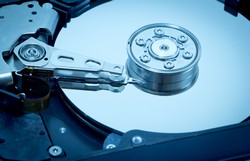Magnetic storage technology heats up
Over the last years, magnetic disk storage density – the number of bits of information stored per unit area – has doubled approximately every 18 months. This trend is expected to continue, indicating the fast rate of technological progress in this field. However, larger storage capacities must go hand in hand with the ability to read and write bits at smaller length scales. The next generation of disk read-and-write heads will use heat to record information and store data, assisted by nanoscale antennas energised by semiconductor lasers that operate at high temperatures. The EU-funded project COMPASS(opens in new window) (Convergence of magnetics and plasmonics through semiconductors) developed lasers that can be integrated with magnetic recording technology and designed antennae that focus the energy on a range of a few tens of nanometres, thereby causing the material to be heated. This heat-assisted magnetic recording (HAMR) approach allows writing on much smaller scales than before, greatly increasing the amount of data that can be held. It enables storage densities of 1 terabit per square inch and beyond. HAMR technology heats the magnetic recording medium with a laser close to Curie temperature to change its magnetic properties while writing data on it. Using electronic design modelling, scientists simulated HAMR heads heating the medium to approximately 100 °C using a laser with 840 nm wavelength and 28 mW. In addition, an improved plasma etching process was developed to form very smooth mirrors that can be used for on-chip laser cavities. This new etching technique allows the laser to be transferred from its native substrate to a new one (just like the ceramic wafer of the read/write head) – a process called transfer printing. This breakthrough technology revolutionises data storage by further pushing current capacity limits, permitting the scaling of data storage in the cloud. Improvements to the storage technology should help advance all forms of data management. A video of the project(opens in new window) is available online.







